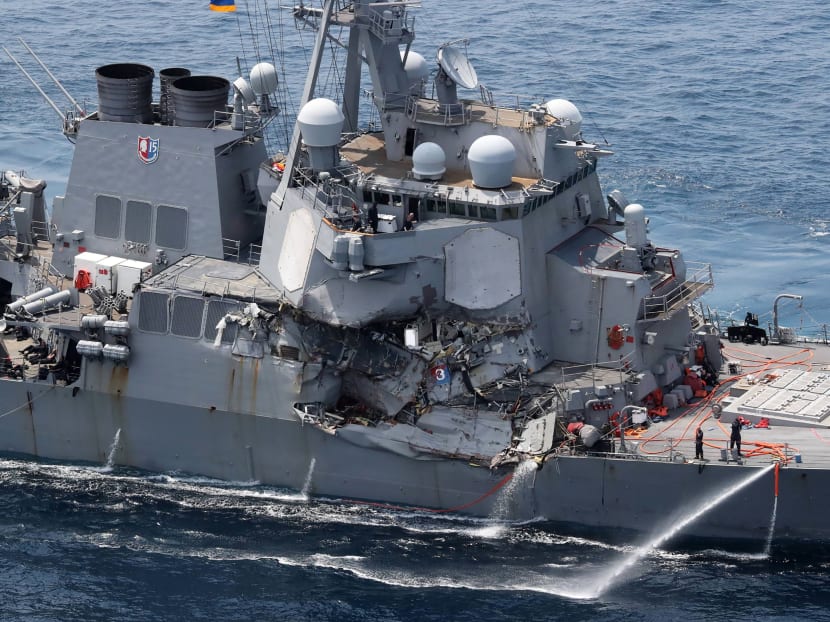Questions loom in the wake of the USS Fitzgerald maritime collision in June
WASHINGTON – The collision between USS John S. McCain and a merchant vessel on Monday (Aug 21) morning was the second accident involving United States Navy destroyers in Asian waters in little more than two months and came days after authorities said inadequate leadership and poor seamanship were behind the first collision.

File photo of the damage seen on the guided missile destroyer USS Fitzgerald off the Shimoda coast, after it collided with a Philippine-flagged container ship, on June 17, 2017.
Photo: AFP
WASHINGTON – The collision between USS John S. McCain and a merchant vessel on Monday (Aug 21) morning was the second accident involving United States Navy destroyers in Asian waters in little more than two months and came days after authorities said inadequate leadership and poor seamanship were behind the first collision.
Early on June 17, the American destroyer USS Fitzgerald had collided with the ACX Crystal, a Philippine-flagged cargo ship, in a busy shipping channel off Japan’s coast. Seven American sailors drowned in their sleeping berth as a result of the accident, which was one of the US Navy’s deadliest in years.
“The collision was avoidable and both ships demonstrated poor seamanship,” said a statement from the US Seventh Fleet last Friday.
“Within Fitzgerald, flawed watch stander teamwork and inadequate leadership contributed to the collision that claimed the lives of seven Fitzgerald sailors, injured three more and damaged both ships.”
The Fitzgerald accident was the third accident involving the US Seventh Fleet during the first six months of the year.
In January, the cruiser Antietam ran aground in Tokyo Bay near its home port of Yokosuka, Japan. And in May, another cruiser, the Lake Champlain collided with a fishing boat off the Korean Peninsula.
The statement by the Seventh Fleet said that the Fitzgerald’s top two officers, Commander Bryce Benson, and his second-in-command, were relieved of their duties by the Seventh Fleet commander, Vice Admiral Joseph Aucoin. A number of other sailors would face disciplinary action, it added.
The statement followed the release of a harrowing preliminary report that detailed the circumstances aboard the Fitzgerald during the accident.
Dozens of sailors who were rocked from their slumber, the report said, raced in the dark to escape from their flooding quarters after the collision. Within 90 seconds, seawater rushing through a gaping hole in the starboard hull was at first waist-deep, then neck-high as sailors pushed aside mattresses, wall lockers and other floating debris to clamber up a ladder to safety. The last sailor pulled from the chaos was underwater when his shipmates yanked him up.
Saving the Fitzgerald and getting it back to its homeport in Japan’s Yokosuka took unusual efforts, the report said.
“Through their swift and, in many cases, heroic actions, members of the Fitzgerald crew saved lives.”
The ACX Crystal also crashed directly into Commander Benson’s stateroom, ripping open a huge hole and trapping him inside. It took five sailors, using a sledgehammer and kettlebell, 25 minutes to break down the door to his cabin to rescue the captain, who was seriously injured and hanging from the side of the ship.
While video footage of the McCain after the collision shows that the damage it suffered does not seem as serious as that suffered by the Fitzgerald, the US Navy said that the ship sustained significant hull damage; while its crew berths, and its machinery and communications rooms are flooded.
Summing up the failures of the Fitzgerald captain and his crew, the vice chief of naval operations, Admiral Bill Moran, said the report made clear that “serious mistakes were made by members of the crew”. As the shipping lanes got more crowded that night, Adm Moran said the sailors on watch “lost situational awareness”, and by the time they realised their errors, it was too late to avoid a collision with the much larger freighter.
What the report did not answer, and what is still under a separate ongoing investigation, is how the collision could have happened. Were lookouts on watch scanning the seas for other ships and, if so, why did they not see the 220m-long ACX Crystal, stacked with more than 1,000 containers, bearing on the destroyer?
How did radar officers on the bridge and in the combat information center below fail to detect the freighter closing in? And why was Commander Benson not awakened and summoned to the bridge, as standard protocol requires, to ensure safe passage?
Admiral Moran said it could be weeks before the investigation is completed into the causes and culpability for the accident.
The USS Fitzgerald and USS John S. McCain, built in the same shipyard, are both ballistic missile defence (BMD) capable ships and part of the same Japan-based destroyer squadron. The Seventh Fleet has six ships assigned to BMD patrols, with half of those out on patrol at any one time. AGENCIES






